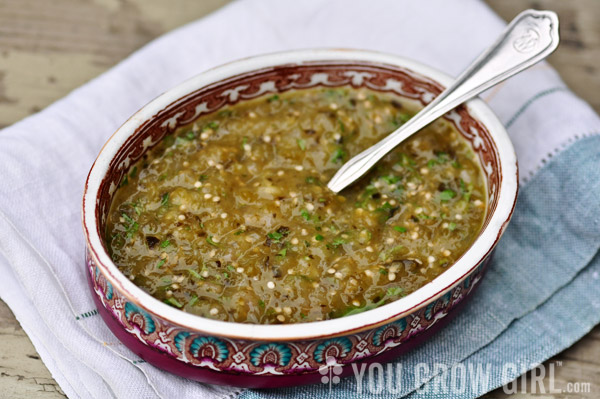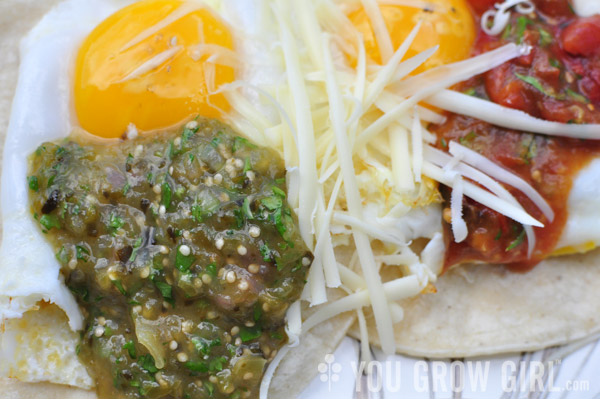
Recently, my friend Margaret of A Way to Garden inquired about harvesting her first big bounty of tomatillos and turning them into salsa verde. If you grow your own tomatillos, late summer is when their papery husks start to plump up and split, signalling that they are ready for harvest. The fruit tends to ripen all at once (or very nearly), and when we spoke, I was just preparing to make up my own annual batch of sauce.
I generally keep my tomatillo sauce as plain as possible so that it can be expanded upon for a wider range of applications. Most years I roast the ingredients in the oven or cook them in a big pot on the stove top without oil and then add lemon juice so that they are safe for canning. This year, while Margaret sought my advice on how to prepare these delicious late summer fruits, I drew inspiration from her and decided to forgo canning, opting instead to freeze the sauce in Mason jars (Margaret is big into freezing in jars). The only freezer space I have available is the small hatch atop an unreliable, and barely functioning 80s era (maybe 90s) fridge. For that reason I typically resort to water bath canning and drying to meet most of my preservation needs. I save precious freezer space for small batches of herbs, seasonal fruit such as strawberries and cherries, and the odd tomato or other produce that I can’t be bothered to can.
I’ve been frantically preserving all manner of things these past few months as if The End Times are coming and so when it came time to deal with the tomatillos I just couldn’t conjure up the drive to fill up the canning pot and make it happen. With canning off the table I was free to make my salsa verde in the way I like it best: roasted in the oven with a little olive oil to help the sugars caramelize with just a hint of char.

Recipe: Oven Roasted Salsa Verde
This recipe made 3- pint-sized wide mouth Mason jars with about a half-pint to spare. We enjoyed a little of the surplus on eggs Huevos divorciados style (two corn tortillas, a fried egg on each with salsa verde on one side and salsa rojo on the other), and the rest was heaped on top of brown rice tortilla chips and devoured.
I recommend using Poblano peppers over bells because they are richly flavoured with just a hint of spice. Feel free to add in a few hot peppers if you like it piquante. Garlic are another good ingredient to add and can be thrown in to roast alongside the onions and peppers. Everything roasted!
Ingredients:
- 2-4 tablespoons olive oil
- 3 lbs tomatillo, husk removed and washed
- 3 Poblano peppers
- 2 small onions, roughly chopped
- 2 tablespoons chopped fresh cilantro leaves (optional)
- Sea salt to taste
Place the tomatillos in a pan and drizzle with a tablespoon or so of olive oil. Place the whole peppers and chopped onions into a separate pan and lightly coat with olive oil. Place both pans in the oven and roast for about 25-35 minutes. Shake the pans and turn over the peppers at about the halfway mark. The peppers are ready when their skins are slightly charred.
Set the pans aside to cool. I find that the pepper skins peel off easily, but if you have trouble you can always put them into a bag to let them sweat for a few minutes. Remove the pepper seeds and core.
Place the tomatillos, peeled and seeded peppers, and onions into a food processor and pulse a few times until the ingredients are lightly chopped with a few chunks remaining for texture.
Mix in the cilantro, if using, and salt to taste.
Pack into jars of any size, leaving a good inch of headroom to allow for heaving and thawing. This prevents breakage. Freeze.
When you’re ready to use, simply set the jar in a bowl and thaw on the kitchen countertop at room temperature.
I’d love your canning recipe. The recipes I’ve tried are too vinegared for me.
Freezing might be a better option for you then. Salsa verde does tend to require a fair bit of acid to make it safe for canning as many of the ingredients are low acid and require that adjustment. You don’t have to worry about that with freezing.
I made a small batch to freeze, but is was so good it never made it to the freezer.
I prepare for the End Times every year. We call it “winter” up here :P
I grew tomatillos for the first time this year, but I had trouble with some bugs, plus I accidentally let most of them overripen since so many resources say to wait until they split their husks. By the time they split the husks the fruit were yellow :(
At least I was growing them more for fun than for something I couldn’t live without :)
I wouldn’t be discouraged by the yellow tomatillos. Some varieties ripen to yellow, and unless they are rotting, I find they just get sweeter when “over-ripe”.
YUM! I am definitely going to make this as I have a truckload of tomatillos out back in the Potager! Thanks for sharing. Yes, Cilantro.
Thank you, thank you, thank you, for recommending growing tomatillos and for being there to answer my questions during growing season. The little darlings finally plumped late in the season and yesterday, I made my first batch of chile verde sauce, seasoned with jalapeno, ancho, and New Mexico chilis. Spectacular!!! Somehow I missed this posting of yours the other day, was going back through email, looking for your email address to thank you for your brilliance, and stumbled on your newsletter, which has been for some dumb reason, not coming into my inbox. Ack. They’re not going to spam, so will have to hunt for the hiding space. Sorry for long story, but just really wanted to thank you for encouraging me to grow this amazing new to me veg. Salsa verde is my favorite and moving from Southern California to New England, and being without easily accessible salsa verde, made growing my own tomatillos the only option. Without your guidance, I would have floundered. Thanks so much, Gayla. Sooo much appreciate you!
I’m so glad it worked out for you! Enjoy that harvest!